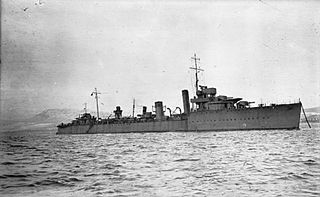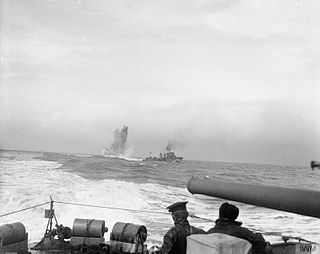
The first HMS Zulu was a Tribal class destroyer launched 16 September 1909 at Hawthorn Leslie Shipyard and commissioned in March 1910. She was mined during the First World War, on 27 October 1916 off Dover in a minefield lain by the Imperial German submarine UC-1. Her stern was blown off and sank, but the forward section remained afloat. It was towed into port and attached to the stern of Nubian, which had been torpedoed, to form a new destroyer named HMS Zubian.

The V and W class was an amalgam of six similar classes of destroyer built for the Royal Navy under the 9th, 10th, 13th and 14th of fourteen War Emergency Programmes during the First World War and generally treated as one class. For their time they were among the most powerful and advanced ships of their type in the world, and set the trend for future British designs.

The Zeebrugge Raid on 23 April 1918, was an attempt by the Royal Navy to block the Belgian port of Bruges-Zeebrugge. The British intended to sink obsolete ships in the canal entrance, to prevent German vessels from leaving port. The port was used by the Imperial German Navy as a base for U-boats and light shipping, which were a threat to Allied control of the English Channel and southern North Sea. Several attempts to close the Flanders ports by bombardment failed and Operation Hush, a 1917 plan to advance up the coast, proved abortive. As ship losses to U-boats increased, finding a way to close the ports became urgent and the Admiralty became more willing to consider a raid.

HMS Ghurka was a Tribal-class destroyer built in 1907 for the Royal Navy. She served as part of the Dover Patrol during the First World War, playing a part in the sinking of the German submarine U-8 in 1915, and was sunk by a German mine in 1917.

HMS Warwick (D25) was an Admiralty W-class destroyer built in 1917. She saw service in both the First and Second World Wars, before being torpedoed and sunk in February 1944.
HMS Phoebe was an Admiralty M-class destroyer built for the Royal Navy during the First World War. She took part in the Zeebrugge Raid in 1918 and was sold for scrap in 1921.

HMS Attentive was one of two Adventure-class scout cruisers built for the Royal Navy during the first decade of the 20th century. Completed in 1905 the ship was placed in reserve until she was commissioned in 1907 as part of the Home Fleet. She then spent the next seven years moving on and off of active service in British waters. The ship sank one destroyer and damaged two others in collisions. Attentive was assigned to coastal defence duties when the First World War began in 1914, and spent most of the war assigned to the Dover Patrol. She played a minor role in the Zeebrugge Raid in early 1918 and was then assigned to escort convoys to Gibraltar. The ship was sent to the White Sea later in the year to support the unsuccessful North Russia intervention in the Russian Civil War. Attentive paid off at the end of 1918 and was sold for scrap in 1920.

HMS Scott was the lead ship of her class of flotilla leaders for the V- and W-class destroyers built during the First World War, and the class would unofficially be named after her. Completed in 1918, the ship was assigned to the Harwich Force and was sunk by either a naval mine or by a German submarine in August while escorting a convoy. The ship herself was the first to bear the name Scott and was named after Sir Walter Scott, 1st Baronet.

HMS Archer was one of 20 Acheron-class destroyers built for the Royal Navy in the 1910s. She was one of the two Yarrow Specials with which the builder was given more freedom in an effort to increase speeds beyond the rest of the class. Completed in 1912 the ship served during the First World War and was sold in 1921.

HMS Wren (D88/I88) was an Admiralty modified W class destroyer built for the Royal Navy. She was ordered in April 1918 from Yarrow Shipbuilders Limited under the 13th Order for Destroyers of the Emergency War Program of 1918–19. She was the third Royal Navy ship to carry the name, which was introduced in 1653.

HMS Tempest was an R-class destroyer of the Royal Navy, built by Fairfield Shipbuilding and Engineering Company at Govan on Clydeside and launched on 26 January 1917 during the First World War.
HMS Murray was a Royal Navy Admiralty M-class destroyer. Ordered before the outbreak of war, she was therefore the first of her class to enter operation during the early months of the First World War. She was also the first vessel of the Royal Navy to carry the name HMS Murray.

HMS Torrent was a Royal Navy R-class destroyer constructed and then operational in the First World War. She was sunk, with most of her crew in 1917. On 23 December 1917 Surprise, HMS Torrent, and Tornado sank after entering an Imperial German minefield.

HMS Surprise was a Royal Navy R-class destroyer constructed and then operational in the First World War. She was sunk, with most of her crew in 1917. On 23 December 1917 HMS Surprise, Torrent, and Tornado sank after entering an Imperial German minefield.
HMS North Star was a Royal Navy Admiralty M-class destroyer constructed and then operational in the First World War. She was sunk in April 1918.

HMS Rob Roy was a Royal Navy R-class destroyer constructed and then operational in the First World War. The ship served in the Grand Fleet as part of the Fifteenth Destroyer Flotilla.

HMS Manly was a Yarrow M-class destroyer of the British Royal Navy. Built by the Scottish shipbuilder Yarrow between 1913 and 1914, Manly served during the First World War. She formed part of the Harwich Force in the early years of the war, and then later in the English Channel as part of the Dover Patrol taking part in the Zeebrugge Raid in 1918. She survived the war, and was sold for scrap in 1920.
HMS Ulleswater may refer to the following Royal Navy ships that are named for Ullswater:

HMS Stork was an R-class destroyer that served in the Royal Navy during the First World War. The R-class were an improvement on the previous M-class with geared steam turbines to improve efficiency. Launched by Hawthorn Leslie at Hebburn in 1917, Stork joined the Harwich Force. The destroyer saw service escorting convoys in the English Channel and encountered both German submarines and torpedo boats, but did not record any hits on the enemy. The vessel also supported attacks on German forces on the coast of Western Europe by Coastal Motor Boats, flying boats and monitors, including the Zeebrugge Raid of 1918.

HMS Mastiff was a Thornycroft M-class destroyer which fought in the First World War as part of the Royal Navy. As a variant of the M-class destroyer, the ship had 6,800 horsepower more than the conventional design, enabling the ship to achieve a speed of 37.5 knots during its sea trials. She was reputed to be the fasted ship in service in 1915.














